 W
WThe Antarctic silverfish is a species of notothen native to the Southern Ocean and the only truly pelagic fish in the waters near Antarctica. It is a keystone species in the ecosystem of the Southern Ocean.
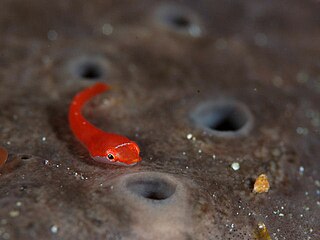 W
WAspasma minima is a species of clingfish found in the Pacific Ocean near the shores of southern Japan. This species grows to 5 cm (2.0 in) in standard length. This species is the only species in the monotypic genus Aspasma. This species was described in 1887 by the German zoologist and paleontologist Ludwig Heinrich Philipp Döderlein from a type collected at a depth of 100-150 fathoms in Sagami Bay, Japan.
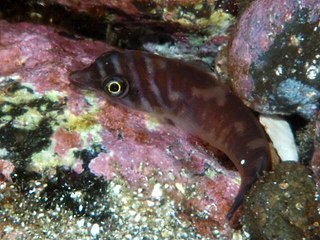 W
WAspasmichthys ciconiae is a species of clingfish found along Pacific coasts from Japan through Taiwan. This species grows to a length of 5 centimetres (2.0 in) SL. The species was described by David Starr Jordan and Henry Weed Fowler in 1902 from types collected from tide pools near Wakayama in Japan.
 W
WAulotrachichthys prosthemius, also known as the West Pacific luminous roughy, is a species of slimehead native to the Northern Pacific from Hawaii to Japan. It can be found at depths ranging from 90 to 198 metres, either in open water or near crevices and caves. It has a maximum length of 6.1 centimetres (2.4 in).
 W
WBelonoglanis tenuis is a species of loach catfish found in the Congo Basin where it occurs in the Congo River basin. It reaches lengths up to 17.2 cm.
 W
WThe blackbelly lanternshark or lucifer shark, Etmopterus lucifer, is a shark of the family Etmopteridae, found around the world in tropical to temperate seas, at depths between 150 and 1,250 meters. Its length is up to 47 centimeters. This species consumes mesopelagic cephalopods, fishes, and crustaceans.
 W
WThe blind electric ray is a little-known species of sleeper ray in the family Narkidae, endemic to New Zealand. It is found on the bottom, typically at a depth of 300–400 m (980–1,310 ft). Reaching 38 cm (15 in) in length, this species has a thin, nearly circular pectoral fin disc without visible eyes, and a short tail with a single dorsal fin. Its pelvic fins are divided in two, with the anterior portion forming a limb-like appendage; in males the claspers do not extend past the disc margin. A weak swimmer, the blind electric ray likely pushes itself along using its pelvic fins. It is known to feed on polychaete worms, and can defend itself with an electric shock. Reproduction is aplacental viviparous. The International Union for Conservation of Nature (IUCN) does not have enough information to assess the conservation status of this species.
 W
WBrachaluteres ulvarum, known commonly as the Japanese inflator filefish , is a species of marine fish in the family Monacanthidae.
 W
WCatostomus conchos, the Matalote conchos, is a species of ray-finned fish in the family Catostomidae. It is found only in Mexico.
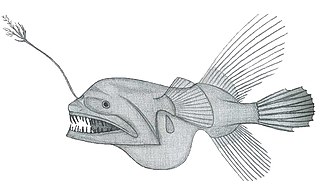 W
WCaulophryne pelagica is a species of fanfin, a type of anglerfish. The fish is found in the bathyal zone at depths ranging from 954 to 2,500 metres.
 W
WChaetodon daedalma or the wrought-iron butterflyfish is a species of butterflyfish native to the western Pacific ocean near central and southern Japan. They can grow up to 6 inches.
 W
WChilochromis duponti is a species of cichlid endemic to riverine habitats in the Chiloango River basin of Cabinda Province of Angola and the Democratic Republic of the Congo, the Kouilou-Niari River and lower Loeme River in the Republic of Congo, and the Nyanga basin and upper Ngounie River which is part of the Ogooué system in Gabon. The main part of its diet is aquatic vegetation, largely algae, but small amounts of invertebrates are eaten. It is spawns on to the substrate. This species reaches a length of 30 centimetres (12 in) SL. It is the only currently known member of its genus. The specific name honours the Édouard Dupont (1841-1911), a Belgian geologist who was a pioneer of the geological exploration of the Congo Basin and a director of the Brussels Museum.
 W
WChiloglanis brevibarbis, the short barbelled suckermouth, is a species of upside-down catfish native to Kenya and Tanzania where it is found in the Athi and Tana River systems. This species grows to a length of 6.1 centimetres (2.4 in) TL.
 W
WCladodus is an extinct genus of cartilaginous fishes in the family Cladoselachidae. As the name implies, they are a type of cladodont, primitive sharks with teeth designed to snag fish and swallow them whole, instead of sawing off chunks to swallow.
 W
WThe Congo puffer or potato puffer is a freshwater pufferfish found in areas of the Congo River in Africa, including rapids.
 W
WCrystallichthys matsushimae is a species of snailfish native to the northwestern Pacific Ocean. It is found at depths of from 30 to 700 metres. This species can grows up to a length of 38 centimetres (15 in) TL.
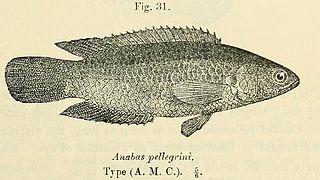 W
WCtenopoma pellegrini is a fish in the family Anabantidae found in the Congo River basin of Africa. It grows to 11.2 cm in total length for a male/unsexed specimen. This species was formally described by the British-Belgian ichthyologist George Albert Boulenger in 1902 with the type locality given as Yembe River at Banzyville in the Democratic Republic of Congo. Boulenger honoured the French ichthyologist Jacques Pellegrin (1873-1944).
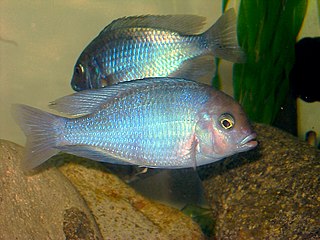 W
WCyrtocara moorii, commonly known as the hump-head, is a species of haplochromine cichlid endemic to Lake Malawi in east Africa where they prefer areas with sandy substrates. It can grow to a length of 20 centimetres (7.9 in) TL. The species is popular among aquarium keepers where it is known as the hump-head cichlid, blue dolphin cichlid, Malawi dolphin or simply as moorii. It is currently the only known member of its genus. The specific name honours the English cytologist and biologist John Edmund Sharrock Moore (1870-1947).
 W
WCyrtocara moorii, commonly known as the hump-head, is a species of haplochromine cichlid endemic to Lake Malawi in east Africa where they prefer areas with sandy substrates. It can grow to a length of 20 centimetres (7.9 in) TL. The species is popular among aquarium keepers where it is known as the hump-head cichlid, blue dolphin cichlid, Malawi dolphin or simply as moorii. It is currently the only known member of its genus. The specific name honours the English cytologist and biologist John Edmund Sharrock Moore (1870-1947).
 W
WThe decorated warbonnet is a fish of the family Stichaeidae. The species name, decoratus, is a Latin word meaning ornamented. The decorated warbonnet was given its name because of the prominent cirri on its head which resembles the feathers in an Indian Chieftain's war bonnet.
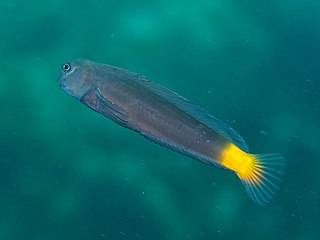 W
WEcsenius namiyei, commonly called black comb-tooth blenny or Namiye's coralblenny, is a species of marine fish in the family Blenniidae. The specific name honours the Japanese zoologist and museum curator Motoyoshi Namiye (1854-1915).
 W
WThe emerald rockcod or emerald notothen is a commercially important species of notothen.
 W
WEnneapterygius etheostomus is a species of triplefin blenny in the genus Enneapterygius. It is a temperate blenny known to inhabit rocky shores in the northwestern Pacific Ocean, and swims at a depth range of 0–21 metres It has been described from Japan, China, Korea, Hong Kong, Taiwan, and Vietnam. Male E. etheostomus can reach a maximum length of 5.5 centimetres (2.1in) Both juveniles and adults of the species are known to feed on benthic algae.
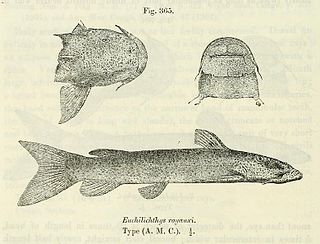 W
WEuchilichthys royauxi is a species of upside-down catfish native to the Congo Basin of Angola, Cameroon, the Democratic Republic of the Congo and Zambia. This species grows to a length of 22 centimetres (8.7 in) TL. Euchilichthys royauxi was named by George Albert Boulenger in 1902 from specimens taken in the Ubangi, its specific name royauxi is in honor of the Belgian officer Louis Joseph Royaux who led the expedition that collected the type specimen.
 W
WThe flapnose houndshark is a houndshark of the family Triakidae, and the only member of the genus Scylliogaleus. It is found in the waters off subtropical South Africa, in the western Indian Ocean between latitudes 27 and 33°S, estimated to be 2 to 4 feet in length. Not seen by biologists since 1902, one was captured in 2020 on the show Extinct or Alive. It was tagged with a pop-up tracking sensor and released.
 W
WThe giant haplochromis is a species of cichlid endemic to Lake Malawi and Lake Malombe, preferring areas with sandy substrates and Vallisneria patches. It is an algae eater, obtaining its food by scraping it from the leaves of aquatic plants. This species grows to a length of 20 centimetres (7.9 in) TL. This fish can also be found in the aquarium trade. This species is the only known member of its genus.
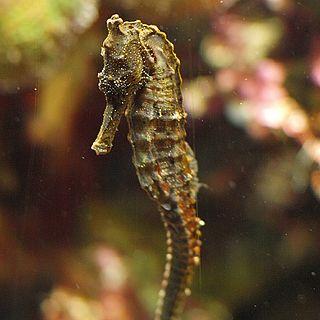 W
WThe great seahorse, also known as Kellogg's seahorse is a species of fish in the family Syngnathidae. It is one of the largest of the 54 species of seahorse.
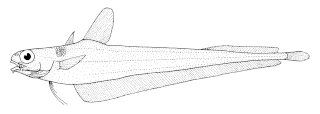 W
WThe grenadier cod or chiseltooth grenadier cod, Tripterophycis gilchristi, is a morid cod of the genus Tripterophycis, found in the mid-south Atlantic Ocean, and around southern Australia, South Africa, Sumatra, and New Zealand. This species is found in marine environments on the continental slope.
 W
WThe ghostly seadevil or soft leftvent angler, Haplophryne mollis, is a species of anglerfish in the family Linophrynidae and is the only species in the genus Haplophryne. It is found in the bathypelagic and mesopelagic zones of tropical and subtropical parts of the world's oceans at depths down to about 2,250 m (7,400 ft).
 W
WSpringerichthys bapturus, known commonly as the Japanese blacktail triplefin, is a species of triplefin blenny in the genus Springerichthys. It was described by David Starr Jordan and John Otterbein Snyder in 1902. This species is found in the western Pacific Ocean from southern Japan to Taiwan. It feeds on algae and the adults occur in rock pools and just below the low water mark.
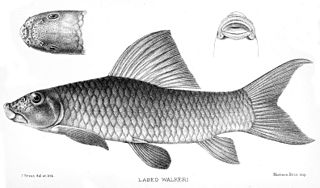 W
WLabeo parvus is a species of fish in the genus Labeo from west and central Africa.
 W
WThe Lacandon sea catfish is a species of catfish in the family Ariidae. It was described by Barton Warren Evermann and Edmund Lee Goldsborough in 1902, originally under the genus Conorhynchos. It is known from the Usumacinta River, in Mexico. It reaches a maximum standard length of 39 cm (15 in).
 W
WLinophryne indica, or headlight angler, is a leftvent anglerfish in the family Linophrynidae, found in the bathyal zone of the Pacific Ocean at depths below 1,000 m (3,300 ft). The female is significantly larger than the mature male. A fossil specimen of this species has been found in the Los Angeles Basin dating back to the Late Miocene, some eight million years ago.
 W
WMicrothrissa royauxi, the royal sprat, is a species of pelagic, freshwater fish from the herring family Clupeidae which is found in the Congo River basin in west Africa. It was described in 1902 by the Belgian-British zoologist George Albert Boulenger. It is of limited importance as a food fish in subsistence fisheries and its conservation status is Least Concern.
 W
WNeoclinus bryope, is a species of chaenopsid blenny found around Japan and South Korea in the western Pacific ocean, and around California in the eastern Pacific. It can reach a maximum length of 8 centimetres (3.1 in) TL.
 W
WPomatoschistus norvegicus, the Norway goby, is a species of goby native to the eastern Atlantic from Lofoten to the western English Channel and has also been recorded from the Mediterranean Sea. It occurs in offshore waters at depths of from 18 to 325 metres, being found on substrates of mud or coarse shell fragments. This species can reach a length of 8 centimetres (3.1 in) TL.
 W
WOpsariichthys evolans is a species of cyprinid fish. It inhabits southeastern China and Taiwan. It has a maximum male length of 9.0 centimetres (3.5 in) and a maximum female length of 7.0 centimetres (2.8 in).
 W
WThe oriental trumpeter whiting, Sillago aeolus, is a widely distributed species of benthic inshore fish in the smelt-whiting family. The species ranges from east Africa to Japan, inhabiting much if the southern Asian and Indonesian coastlines. Its morphology is very similar to other species within the genus Sillago, with a long, compressed body and silvery overall colour. It can be distinguished from its relatives by colour patterns and particularly swim bladder morphology, which helps define most species of Sillago. S aeolus is a benthic predator, consuming a variety of crustaceans and polychaetes. As with most members of the smelt whiting family, it is important to small coastal fisheries in various areas of its range.
 W
WOrthochromis stormsi is a species of cichlid endemic to the Democratic Republic of the Congo, where it is known from the upper Congo River basin and Lake Mweru. It has also been reported from Pool Malebo and the Regina Falls in the lower Congo River basin, but the identity of these populations requires further investigation. This species can reach a length of 10.2 centimetres (4.0 in) SL. The specific name hours the Belgian Army Lieutenant Maurice Joseph Auguste Marie Raphael Storms (1875-1941) who collected the type which he presented to the Brussels Museum.
 W
WThe ploughfish is a species of Antarctic dragonfish found at depths of from 0 to 550 m over the Antarctic continental shelf. This species grows to a length of 34 cm (13 in) SL. This species is the only known member of its genus.
 W
WPolypterus ornatipinnis, the ornate bichir, is a bony fish found in Lake Tanganyika and the Congo River basin in Central and East Africa.
 W
WPseudanthias cooperi, the red-bar anthias is a Pseudanthias fish from the Indo-Pacific Ocean that occasionally makes its way into the aquarium trade. It grows to a size of 14 cm in length. The identity of the person honoured in the specific name is not specified in Regan's account but it is thought to be Clive Forster Cooper (1880-1947), who was a member of the expedition on which the type was collected in the Maldives.
 W
WPuntigrus anchisporus is a species of cyprinid fish endemic to Borneo. This species can grow to a length of 6.6 centimetres (2.6 in) TL.
 W
WThe sinarapan or tabyos is a species of fish in the goby subfamily, Gobionellinae, and the only member of the monotypic genus Mistichthys. It is endemic to the Philippines, where it occurs along the Bicol River and in Lakes Buhi, Bato, Lakelets Katugday and Manapao in Camarines Sur and in Danao Lake in Polangui, Albay.
 W
WSturisoma frenatum is a species of armored catfish endemic to Ecuador where it occurs in rivers. This species grows to a length of 24 centimetres (9.4 in) SL.
 W
WSynodontis longirostris, known as the eyespot synodontis, is a species of upside-down catfish that is native to the Democratic Republic of the Congo where it occurs in the Congo Basin. It was first described by British-Belgian zoologist George Albert Boulenger in 1902, from specimens obtained in the Ubangi River at Banzyville. The species name longirostris comes from the Latin word longus, meaning "long", and the Latin word rostrum, meaning snout, referring to the long snout on this species.
 W
WSynodontis multimaculatus, known as the dotted synodontis, is a species of upside-down catfish that is native to the Democratic Republic of the Congo where it is found in the Ubangi River. It was first described by British-Belgian zoologist George Albert Boulenger in 1902, from a specimen collected in the Ubangi River in Mobayi-Mbongo, the Democratic Republic of the Congo. The species name multimaculatus is derived from the word multi, meaning many, and the Latin word maculatus, meaning spots, referring to the many spots on the fish.
 W
WSynodontis smiti, known as the longtail Synodontis, or Smit's Synodontis, is a species of upside-down catfish that is endemic to the Democratic Republic of the Congo where it is found in the middle and upper Congo Basin. It was first described by British-Belgian zoologist George Albert Boulenger in 1902, from specimens obtained in the Ubangi River at Banzyville. The species name smiti is named for Pierre Jacques Smit, who illustrated the plates in Boulenger's works.
 W
WTrachyglanis minutus is a species of loach catfish found in the Ubangi River in the Republic of the Congo and the Democratic Republic of the Congo. It grows to a length of 5.0 cm.
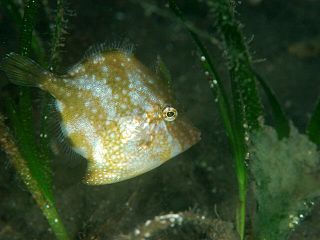 W
WThe Whitespotted pygmy filefish is a species of reef filefish in the family Monacanthidae. It is a small fish, growing to only 5 cm (2 in), and is found in the temperate waters of Japan. It is kept in captivity and has been successfully captive bred.
 W
WZigzag barb is a species of cyprinid fish in the genus Enteromius which occurs in the Congo Basin, Okavango River, Kafue River and the upper Zambezi.